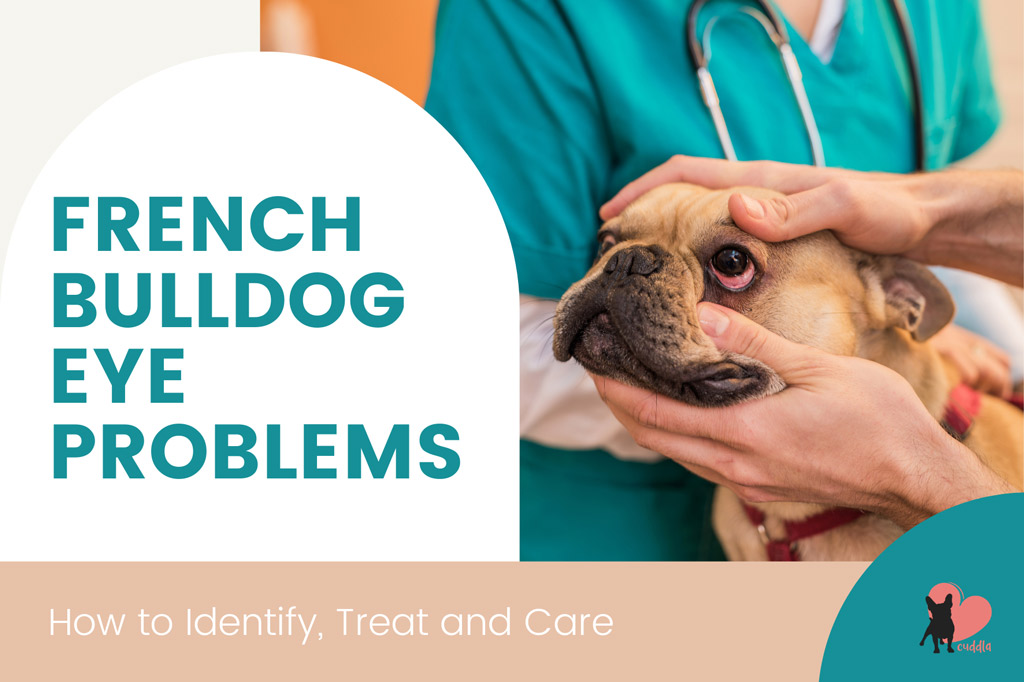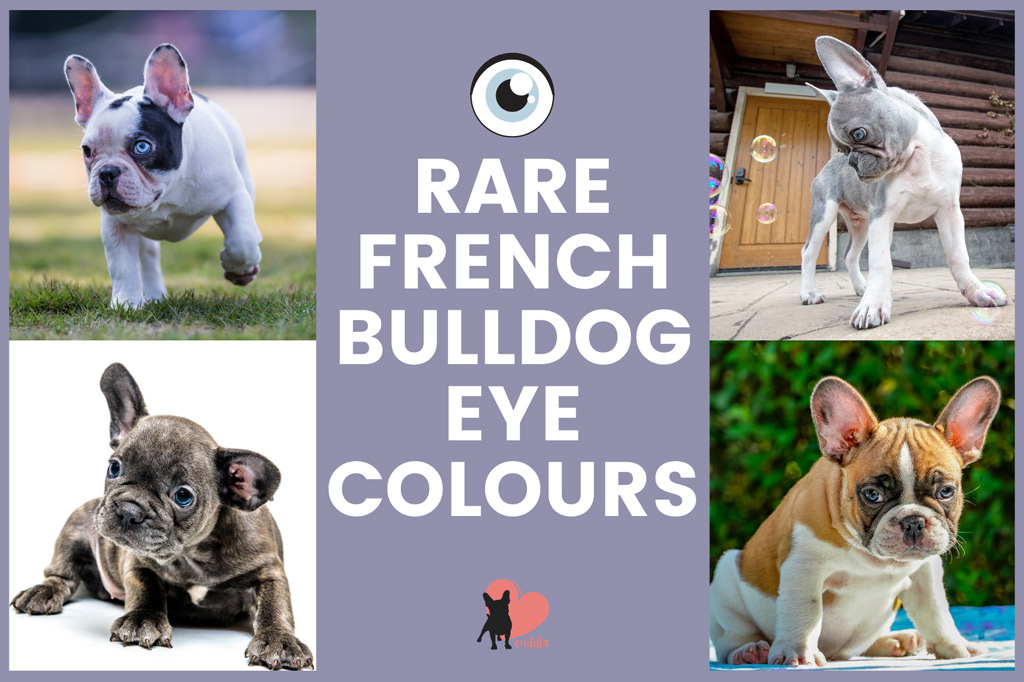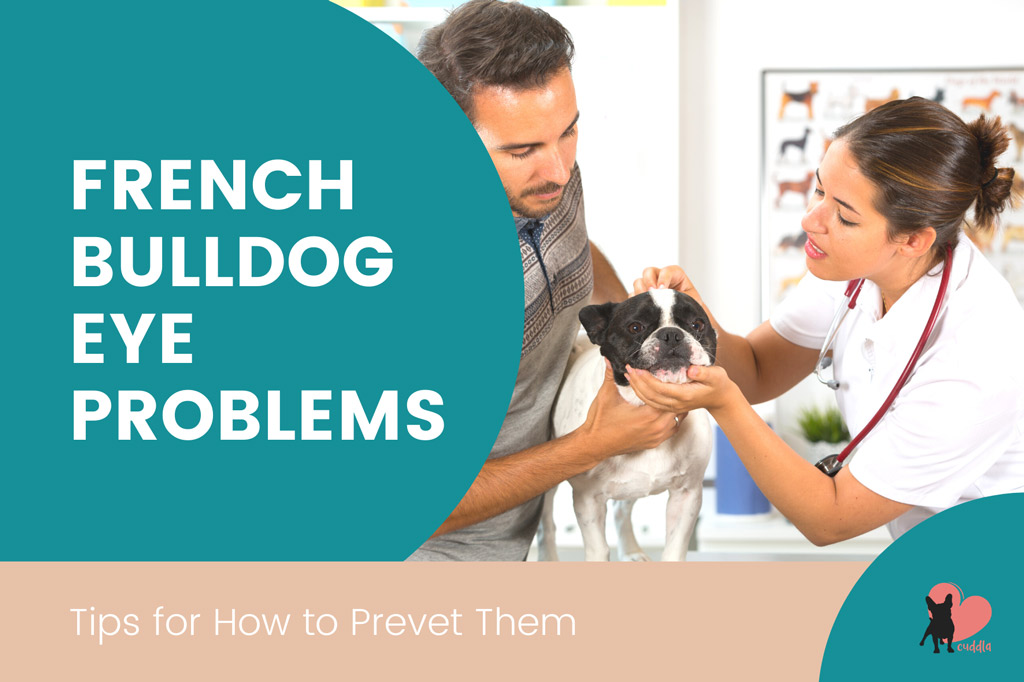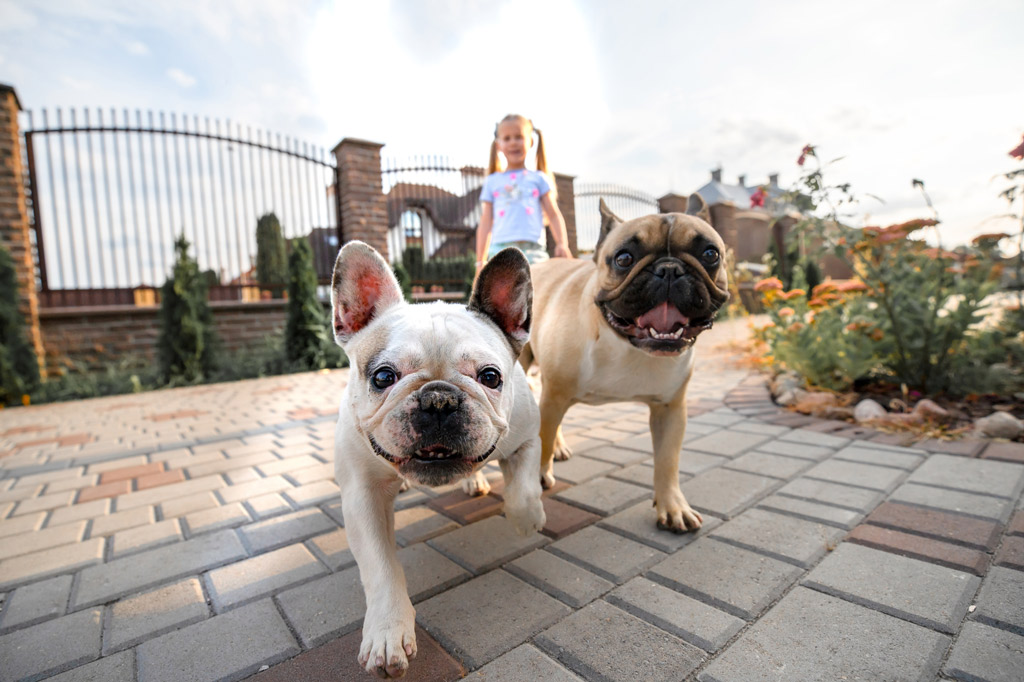
French Bulldogs are prone to having eye problems and a common sign that something is wrong is their red eyes.
In this guide, you will find out how to identify an eye problem in your French Bulldog (what signs to look for) and what you can do to prevent and treat them.
French Bulldog Eyes Colour and Shape
According to the AKC Breed Standards, French Bulldogs’ eyes are dark in colour: brown or approaching black in colour.
Lighter brown coloured eyes are acceptable, but not desirable in terms of breed standards.
However, there are 4 reasons that would disqualify a French Bulldog from the breed standard:
- Blue or green eye(s).
- Any traces of blue or green.
- No haw (the third eyelid).
- No white of the eye showing when looking forward.
So while french bulldog with blue eyes do exist, that eye colour is a reason for disqualification from the American Kennel Club.

In terms of shape, their eyes are wide apart, round in form and of moderate size, i.e., neither sunken nor bulging. But they are slightly protruded, which means they are easily injured.
So, if you have come across the question do French Bulldog eyes pop out or fall out?
Now, you know that their eyes don’t bulge or pop out from their eye sockets.
With that being said, let’s move on to the main topic: Frenchie’s eye problems.

French Bulldog Eye Problem Signs
You might not be able to know which eye condition your Frenchie has, but that’s what veterinarians are for.
As a dog owner, the best thing you can do is to monitor your dog’s eyes for any changes.
Here are some signs that your French Bulldog has an eye problem:
- Red eyes or bloodshot eyes.
- Excessively watery eyes.
- Excessively dry eyes.
- A noticeable increase in eye discharge.
- Change in eye discharge consistency or colour.
- Rubbing or pawing at the eyes.
- Excessive blinking.
- Different sized eyes.
- A visible foreign object in the eye.
If any of these occur, don’t hesitate to take your pooch to your vet for an appropriate diagnosis.

French Bulldog Eye Problems
Here are 3 reasons why you should put concern on your French Bulldog’s eyes:
- French Bulldog’s eyes are slightly protruded, which means they are easily injured and can be prone to infection.
- Frenchies’ experience food and skin allergies that can irritate their eyes.
- They also suffer from hereditary eye diseases such as cataracts.
These issues can develop into more serious health problems, which can even lead to blindness.
Dry eye (Keratitis Sicca), cherry eye, bloodshot or red eyes (Keratoconjunctivitis Sicca, Distichiasis or Entropion), and corneal ulcers are the most common eye problems for French Bulldogs.
#1 – Keratitis Sicca (Dry Eye)
Keratitis Sicca, also known as Dry Eye, happens when an ulcer damages the cornea of your dog’s eye. The cause is an inadequate tear production.
Tears are necessary for lubrication and overall eye health. When your dog is not producing enough tears, the surface of the eyes becomes irritated and sore.
This can cause ulcers to form and can result in painful and chronic eye infections.
In severe cases, it can lead to perforation of the eye itself. In chronic cases of dry eye, the surface can scar, creating a cloudy, dull appearance.
Dry eye is often associated with an autoimmune inflammation of the tear glands and can be a chronic, lifelong condition.
Signs:
- Cloudy eyes.
- Dull and dry eye appearance.
- Mucus discharge from the eyes.
- Redness around the whites of the eye.
- Swelling of the tissue on the surface of the eye and eyelids.
- Squinting or excessive blinking.
Treatment: Dry Eye can usually be treated with tear-stimulating medications and topical antibiotics. In severe cases, there are surgical options available (source).
Prevention: Regular eye check-ups. Diagnosis includes an eye exam and sometimes a test to measure the amount of tear production and moisture in the eye.
#2 – Cherry Eye
Cherry eye is a painful condition that affects a French Bulldog’s third eyelid called the haw – which is a breed trait.
It happens when the gland (located on that third eyelid) pops or bulges out of its original position. As a result, it swells up outside the eye, causing the unsightly cherry eye.
Cherry Eye is a congenital defect that has a breed predisposition, but the mode of inheritance is unknown.
Signs:
- Similar to a tumour in the eye.
- A bright red mass protruding out of the eye.
Treatment: Cherry Eye may need to be corrected surgically to reposition the third eyelid and the tear gland.
Prevention: Again, regular eye check-ups.
#3 – Distichiasis
An eye condition where too many eyelashes grow around a French Bulldog’s inner surface of the eyelid.
It can cause discomfort and may cause corneal ulcers to develop. Corneal ulcers may not heal because of the irritation.
Also, Distichiasis may occur at any time in the life of a dog.
There’s no evidence to prove that is a hereditary condition but it seems probable due to the high incidence in some breeds like French Bulldogs.
Signs:
- Eye irritation.
- Too many eyelashes.
Treatment: Removal of the hairs (by the vet) is usually the solution.
Prevention: Regular eye check-ups.

#4 – Entropion
Another eye condition where the eyelashes grow inwards, causing the hair to rub against the eyeball.
It can cause a reddened, inflamed eye, severe infections and deep ulcerated cornea. It’s also believed to be a hereditary condition.
Signs:
- Redness in the eye.
- Inflamed eye.
Treatment: Eyelid surgery.
Prevention: Regular eye check-ups.
#5 – Corneal Ulcers
Due to how prominent French Bulldog’s eyes are, corneal ulcers are particularly common.
It’s a painful eye condition that is initially caused by trauma to the cornea of the dog’s eye. That can look like:
- A scratch or an injury to the eye.
- Eye irritation.
- From particles in the environment like dust and sand.
- From eyelashes or facial hairs.
- An infection.
- A lack of moisture in the eye.
Signs:
- Repeated eye rubbing.
- Keeping one of the eyes closed at all times.
Treatment: Corneal ulcers can be difficult and expensive to treat and can result in the loss of the eye. In mild cases, the ulcers can heal following your vet’s specific treatment.
Prevention: The best way to prevent it is to protect your French Bulldogs’ eyes from hazards. Continue reading for some helpful tips in this matter.
#6 – Cataracts
Cataracts is a condition where the eye’s natural lens gets cloudy, causing a decrease in vision clarity, and will eventually lead to blindness. But, cataracts may remain the same in size and shape over time too.
French Bulldogs can suffer from a hereditary cataract condition called Juvenile Cataracts, which starts to appear by 15 months of age.
This form of genetic cataract is always bilateral (affecting both eyes) and progresses rapidly. If a puppy is found to have cataracts, it means BOTH parents are carriers for the condition.
However, cataracts may also develop due to (source):
- Trauma to the eye.
- Metabolic diseases such as diabetes.
- Nutritional disorders during puppyhood.
- Or secondary to other eye diseases.
Signs:
- Bluish, grey or white colour change inside the eye.
- A tendency to bump into things.
- Reluctance to climb the stairs or jump onto the couch.
- Hesitancy in unfamiliar environments.
- Inflammation or redness of the eye.
- Pain and squinting.
Treatment: There is no medical treatment available to reverse cataracts, to prevent cataracts or to shrink cataracts. Whether a dog is a candidate for cataract surgery can be determined by a veterinary ophthalmologist.
Prevention: Usually, cataracts are an inherited trait. So, unfortunately, there’s not much you can do to avoid it if your dog has inherited the HSF4 gene.
However, if you are looking to get a French Bulldog puppy and are concerned, commercial genetic tests are available (CERF examination) I will go more into detail later on.

5 Tips to Prevent French Bulldog Eye Problems
How can I stop my French Bulldog from having eye problems?
Here are 5 tips to address eye problems before they occur.
#1 – Have a Dog Insurance
Part of the prevention plan is to have good dog insurance.
Since Frenchie’s are prone to have eye problems and other health issues that are breed-related, these will add to the vet bill.
Petplan Pet Insurance covers all hereditary and chronic conditions as standard. Which means if your French Bulldog inherits her dad’s bad eyes or her mom’s patchy coat, you’re covered.
#2 – Take Your Dog for Regular Check-Ups
Regular check-ups, including an eye examination, are especially useful to spot a problem or signs in advance.
For instance, you could visit your vet twice a year, with the change of season (spring and autumn), for a general check-up.
For eye-checks, it’s necessary to visit a veterinary ophthalmologist to have a more thorough examination. A specialist will examine your dog’s eyes using an indirect ophthalmoscope and a slit lamp biomicroscope.
How often you take your pooch to the ophthalmologist will depend on your French Bulldogs’s health history: recorded hereditary conditions, a current eye problem…, etc.
Ideally, you have your French Bulldog’s health records, which include genetic test and health certificates.
Without a genetic test, which detects hereditary eye conditions, your best defence is:
- An OFA eye examination (certificate: Companion Animal Eye Registry or CAER exam). This health certification is registered with the Orthopedic Foundation for Animals.
- A genetic test for the gene for Juvenile Hereditary Cataracts (JHC) by a certified testing service or genetic testing records that neither parents are carriers of this gene that causes to go blind early in life.
Finally, to verify the results of these tests, check the OFA website here, then select the breed and type in the breeder’s kennel name. The results on all their dogs should come up.
The American Kennel Club also recommends an Eye Examination by a boarded ACVO Ophthalmologist and Juvenile Cataracts test (source).
P.S. Bear in mind that these health tests cannot be completed before a dog is two years old. So you won’t be able to test your pooch until then. Also, please don’t buy from someone that is breeding their dog before she’s two years old.

#3 – Clean Your French Bulldog’s Eyes Weekly
Your Frenchie’s eyes need special care because of how prominent they are. Keeping your dog’s eyes clean and dry is very important to prevent eye infections and other issues.
At least once a week, you should take the time to look at your French Bulldog’s eyes and clean any specks of dirt around them.
Rather than using eye solutions, I prefer grooming wipes (these ones are free of alcohol, parabens and harsh chemicals).
Wipes are useful to wipe the excess tears from the fur beneath the eye and prevent staining – Epiphora, another eye condition known as watery eyes, causes tear stains.
This routine will help you to keep an eye out for signs of eye infections mentioned above (French Bulldog Eye Problems Signs). Always take your dog to the vet at the first sign of trouble.
#4 – Feed Your Frenchie a Balanced Diet
Nutrition also plays a role in French Bulldogs’ health, including their eyes.
Plus, due to their food allergies, which can cause eye irritation, you should pay particular attention to your French Bulldog’s diet.
A species-appropriate balanced diet, according to their age, will make sure your dog gets all the nutrients needed for a healthy and long life.
French Bulldogs should follow a balanced diet, which includes:
- High-quality protein: Lean-muscle meats, fish and eggs.
- Moderate level of animal fat: Salmon and sardines.
- High levels of EPA and DHA: Omega-3 from krill oil.
- A few fresh cut veggies: Broccoli and kale (mimics prey’s stomach contents).
- No grains (gluten-free).
- No potatoes or other starches.
- No artificial flavouring.
Plus, your furry friend should be well hydrated with fresh and filtered water (if necessary in your area).
Read also: Best Diet for Boston Terriers with Sensitive Stomach – where I will focus on best diets for dogs with food intolerance and allergies. This is also valid for Frenchie owners since both breeds suffer from the same food allergies.

#5 – Keep Your Dog’s Eyes Safe From Hazards
Because French Bulldogs’ eyes bulge out from their faces you need to be especially careful.
Basically, avoid having your dog in close contact with anything that could potentially scratch the eyes.
Here’s what you can do:
- Around the house: Be mindful about how you arrange the furniture so that your dog doesn’t bump into it.
- When playing with toys: Make sure that none of your dog’s toys has sharp edges. Here’s a guide to safe dog toys.
- Around the garden: Avoid thorny plants such as roses or cactus, or make sure that area is not accessible to your doggie. Also, when going for walks, never allow your pooch to get close to thorny plants or bushes.
- During car trips: Don’t allow your dogs to stick their heads out. In any case, windows should be always closed, and if open, only enough for some fresh air to come through.
- Walking in dusty terrains: Dust and sand can become a hazard, especially when it’s windy. So avoid walking with your Frenchie in excessively dusty conditions or on windy days. It can be helpful to carry dog eyewash drops with you to wash out any particles that get into your dog’s eyes before your dog rubs the eyes, risking scratches. Some dog owners even use dog goggles (for windy days and for swimming), which I had no clue that they existed!
Best wishes on your dog parenthood journey!
